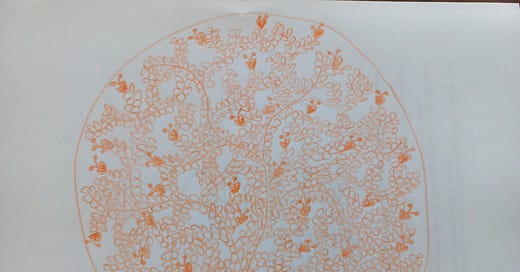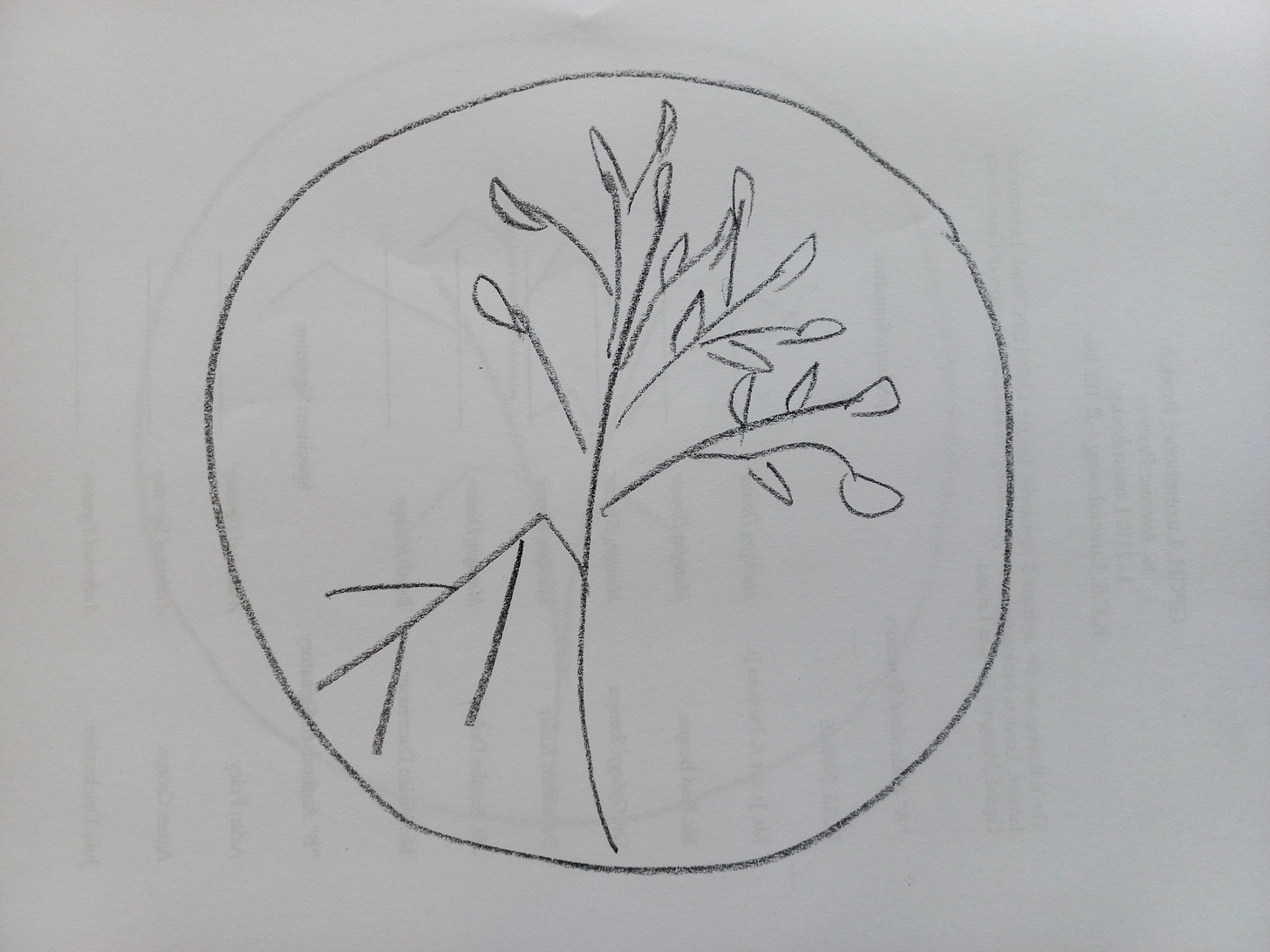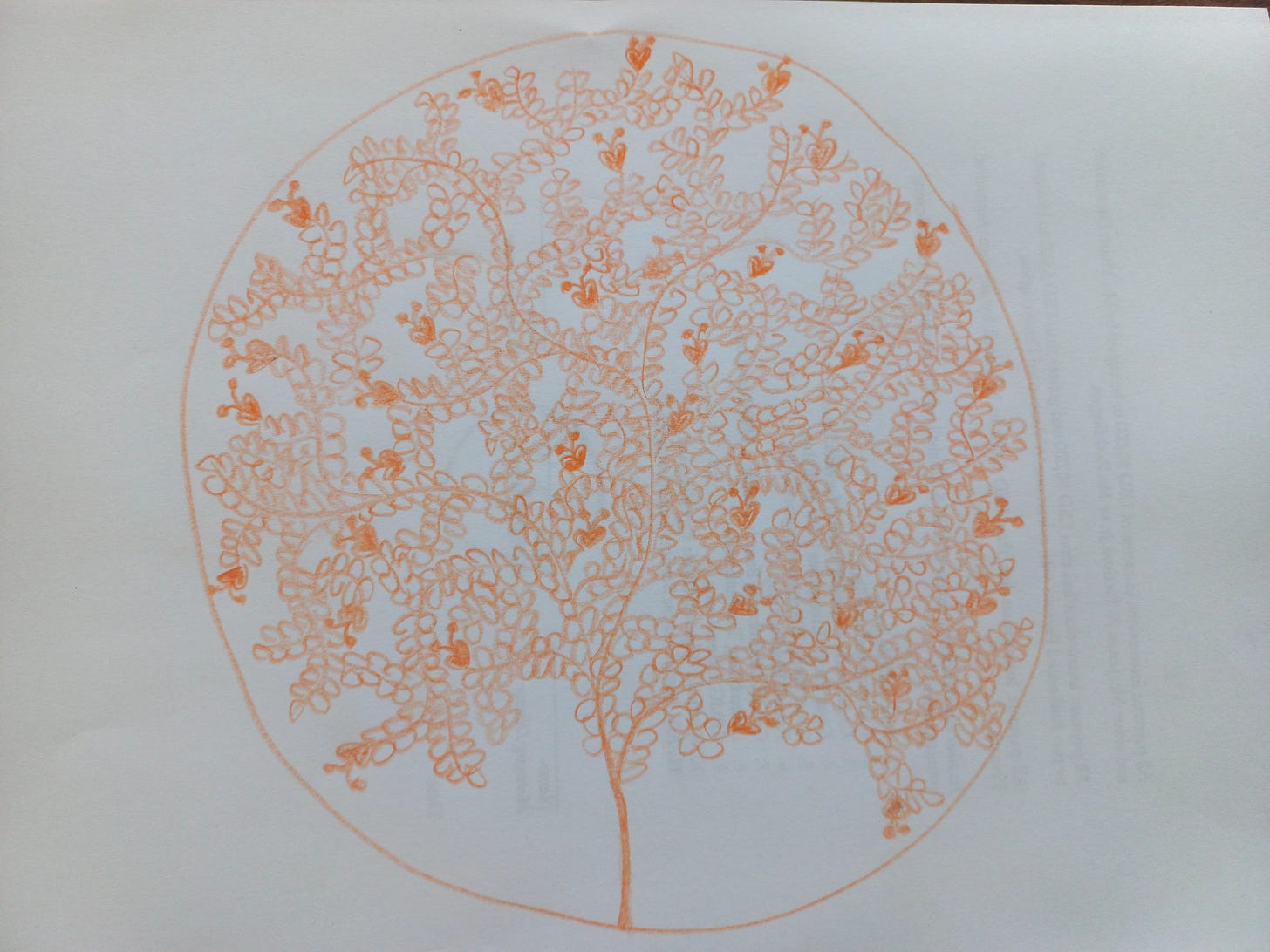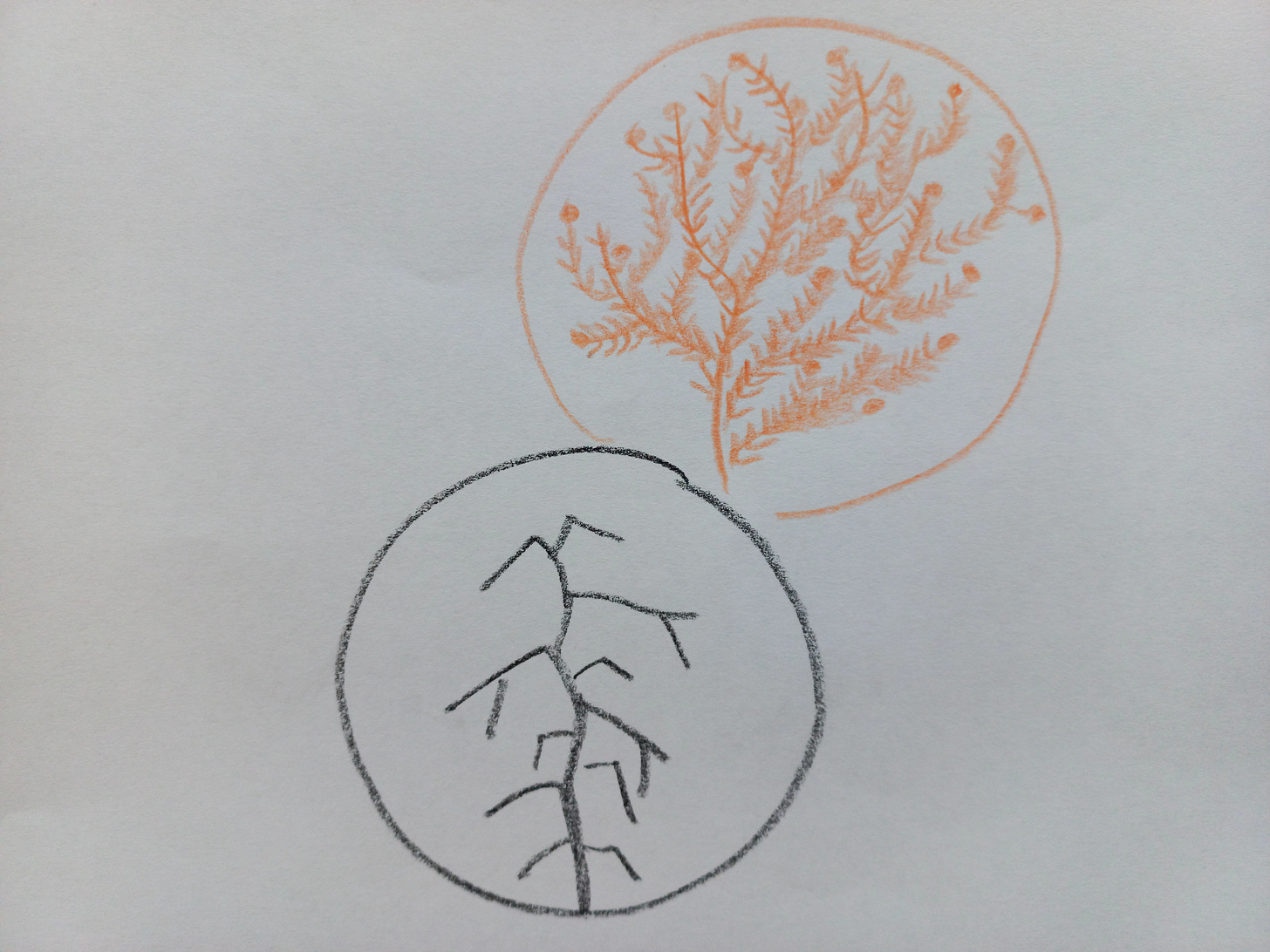The following is an excerpt from my book in process for therapists: Straightening Souls.
I don't know how I came to realize that when I work with someone, I always have two images in my mind. These pictures very accurately show the psychological characteristics of the client on two distinct levels. One image is a dark, tree-like shape depicting the patient's current state, the things they want to get rid of. For example, if there is a deep split in their personality, the trunk of the tree shows up double.
Or the patient’s life could be endlessly bleak because it consists of slaving away in some drab workplace and then going home and watching porn on the internet. In this case flowers and leaves will be conspicuously absent.
If they had a major trauma, it will show up either as a healed scar, or, if it continues to haunt them unresolved, as a break.
Then there is a somewhat larger, golden-yellow image appearing above the black one that shows the patient's original, inner self. As they were born, before all the things happened that distorted their personality.
Everything I do with the person is, at some level, focused on directing their attention (not necessarily their conscious attention) to the golden image. Patients typically identify with the picture showing the current, temporary situation. They believe their flaws to be integral parts of their personality. As healers, however, we must know that these are but transitory, superficial phenomena. The true self of the person is illustrated by the golden image. That original pattern is the real one, the powerful one, the genuine one, the one transcending time and space. During the course of therapy you are constantly enticing, evoking that self. In order to actually bring it to the surface, all kinds of methods and rituals will be useful, but the first and foremost thing is knowing that you are sitting across a beautiful, healthy, round, golden, perfect being.
Although they are more uniform than the black pictures, people's golden images are not the same. Some individuals have more refined, delicate branches, some have a simpler branch system, some have more energy flow. We differ from each other just as trees do. But in contrast to the stunted condition of the transitory, black state, everyone's true self is beautiful, symmetrical, harmonious and radiant.
Unfortunately, the fundamental assumption of most modern psychology is not exactly that people are essentially okay. You, on the other hand, can be absolutely convinced of this when you see the real self of the person that’s sitting in front of you. I think that is a necessary precondition for any effective therapy. If you don't believe that your clients have the blueprint for healing, how are you going to convince them? Most patients have invested quite a lot in their problems and on some level are quite attached to how messed up they are. You can even pace that in some way to build rapport with their conscious mind. Yes, of course, you had such a difficult childhood. Poor thing. At the same time, you keep on pointing out to them that, my dear friend, this other image is who you really are. After a while the call becomes irresistible, because, besides making them feel better, it is actually, in some ways, more real than the surface wreck they had identified with.
Of course, this plant-like image is just one way of representing where you are heading. It might be interesting to check if you have some unconscious structure with a similar purpose. If one has not appeared yet, you can allow it to emerge in its own time and in its own way. The point is to somehow represent the potential in the person which will be brought to surface in the course of therapy.
Of course, all this only works if you believe that people are born perfect. Today's Western psychology keeps “discovering” pathological conditions with complicated names, often implicitly assumed to be hereditary or physiological. If you think like that, find another profession for yourself. The blacksmith who starts hammering with the idea that iron is a lousy, brittle, unmalleable material will not succeed. Better to become a letter carrier or a data analyst than to ruin people's lives with your defeatism disguised in a scientific cloak. It’s very important to understand that in therapy, “objective reality” is not what matters. When you’re shaping people's inner world, your field is subjective reality. Reality will come to the surface anyway. But embarking on a trip around the world with your ankles tied is not the best preparation. Starting someone else out like that is even worse.
Would this mean that there are no imperfect people? No, the real self of a genetically defective person, like someone with Down syndrome, will look different. Since I haven’t worked with such people I don’t know what their tree would look like. But even someone with Down syndrome has a margin for improvement, although not as much as a healthy individual. And we have to be very, very careful whom we classify as “genetically defective”. Schizophrenia, ADHD and many other ailments are not in the hardware, but in our minds, in the way we think about these conditions and behaviors.
A long time ago a very intelligent young woman came to see me. She had, oh, so many problems. Her life was falling apart, she couldn't finish university, and she was having difficulties in more and more areas in her life. She was diagnosed as depressed, having panic disorder and I can't remember what else. I listened to her intently for an hour and a half, only asking clarifying questions to understand where she was coming from and where she wanted to go. She detailed all the things that were wrong with her, what medication she was prescribed and how hopeless her life was. At the end she looked at me expectantly. I looked straight into her eyes.
You know, I said, sometimes you get bitten by a mosquito. The bite itches, and if you scratch it too much, it may become an open wound. Naturally this scares you, you put all kinds of ointments on it that make it worse, so you put more on it and it gets even worse, and at the end you think your arm will have to be amputated. What happened is that you panicked a bit, things got out of control, and now you're imagining all sorts of terrible things about yourself. But basically, as far as I can tell, there's nothing wrong with you.
I paused to have that sink in, then continued. In fact, you’re completely OK, what happened is that you've lost your balance and your faith, and of course we’ll have to work on getting them back which will not always be easy. But you should know that you're perfectly fine. And because you have all the skills to be well and to achieve your goals, we're going to work those things out.
Something in her visibly relaxed. She continued to see me for nine months after that, and did all sorts of other rather daring things, like quitting her medication cold turkey without consulting anyone. She also quit smoking and made some other important changes. The best thing was that it wasn't me who helped her with everything. She took every opportunity to change, graduating with honors at the end. We had infrequent sessions, some of which lasted for four hours, during which we laughed a lot and wrestled a lot. Yet, as far as I could tell, all this, the rest of therapy, was just streamlining. The essence of healing happened in that first session, when this human being, even if at that time only conditionally, got in touch with her resources.
If you think of people as broken pieces of biological hardware that need to be glued together with chemical goo, or have to be babied for years to make minimal progress, and you convey that to them when they open themselves up to you in a suggestible state, then that's what you'll get. When someone comes to a therapist and gives up some of their control over themselves, the therapist's first task, like that of a good parent, is to restore the patient's faith and confidence and to create a framework in which their goals can be achieved. If you don't feel that you can do this with someone, refer them to someone else. “For this kind of problem I can recommend Mrs so-and-so, she’s a specialist in this area.” Or, if you don't have colleagues you can refer people to, take the blame. “Unfortunately, I don't have expertise in that kind of situation.” I don't think you have the responsibility to help everyone. Improving the lives of those with whom you resonate is plenty.
As healers, one of our main tasks is to assume the patient has resources and abilities and to constantly transmit this knowledge to them. The main message is: You are good. You can reach your goals. You can heal. When this is communicated authentically, with congruence, the person's unconscious mind will discover the way to their well-being. This is one of the most important parts of therapy.
And, we could add, of everyday communication.







